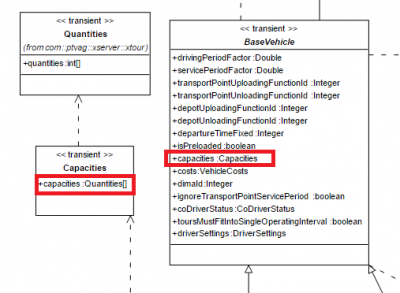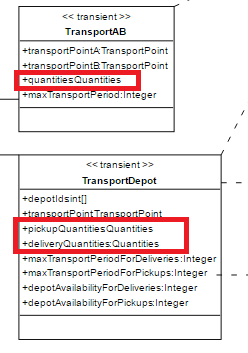Hello Joe,
the properties you are looking for are indeed a bit tricky but not rocket science.

- Quantities are related to Vehicles...

- and orders...
- Quantities.order.PNG (11.3 KiB) Viewed 9326 times
Let's start with an order based on the properties mentioned in the example: "weight, volume, turnover".
That means you have to work with an int[3] array in the context of a planning task (single transaction).
- Order #1: 500kg, 5 Pieces, 10000€ so you can use int[3]=new int[]{ 500 , 5 , 10000 }
- Order #2: 700kg, 3 Pieces, 15000€ so you can use int[3]=new int[]{ 700 , 3 , 15000 }
- Both orders at the same vehicle at the same time? that's simply like new int[]{ 1200 , 8 , 25000 }. Just add the components of the array
Now look at the vehicle.
Example:
Quantities of the vehicle new int[]{ 700 , 5 , 15000 }. Such a vehicle pattern would be able to transport Order #1 and Order #2 but NOT at the same time (because the combined array exceeds at least one of the components.
In other words: a set of orders can be handeled at the same time on a vehicle if every aggregated component of the orders is lower equal than the assigned component of the vehicle.
In the end you are free in how to define the meaning of those up-to-ten components... so whether you define
int[] = { weight in kilograms, turnover in euros , number of palettes } or just int[]{ number of pieces } : both is possible as long as you treat every QUANTITY within a transaction in the same way.
It could be very important to determine the proper sequence if you want to perform BALANCING based on QUANTITIES because this considers the primary component of the vector only. So if you want to balance over turnover you need to use the turnover as component [0].
And there is even more functionality available: check the loading patterns! A vehicle is not only able to deal with a single QUANTITIES pattern but with several of them. If at least one of the vehicles patterns (each one reflects current physical conditions depending on current setup) matches the orders: DEAL! Only thing to be considered: the pattern of the vehicle can't change within a tour (this might be possible in reality but not in the API).
Does this answer your question?
Best regards Bernd